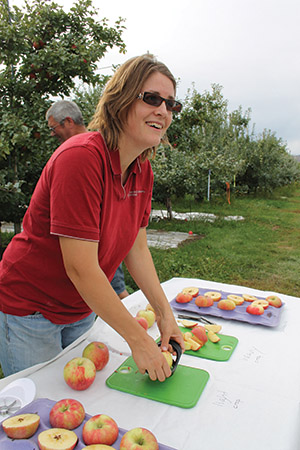
WSU extension specialist Gwen Hoheisel offers samples of Honeycrisp apples picked from overcropped and moderately cropped trees for comparison.
Marketers says taste, rather than appearance, is what drives consumers to buy apples, and at a pre-harvest Honeycrisp field day in Washington, growers had a chance to compare apples picked from trees with a moderate crop load with those from overcropped trees. The difference in flavor was dramatic.
Dr. Ines Hanrahan, project manager for the Washington State Fruit Commission, said the crop load can also affect storability.
Washington Honeycrisp growers are advised to pick fruit for long-term storage from evenly loaded trees, not overcropped trees.
Fruit on overcropped trees can have delayed color development and the starch can be fully converted to sugars before the fruit is ready to pick colorwise, she said. For storability, fruit needs some remaining starch and should be picked at a reading of 4 to 5 on the Honeycrisp starch iodine index that can be found on the Washington Tree Fruit Research Commission’s Web site at www.treefruitresearch.org.
Some people claim to have grown 120 bins per acre of Honeycrisp and had good return bloom, but Hanrahan said Honeycrisp yields need to be somewhat lower than with other varieties.
“If you don’t get fruit that tastes good on the trees, your crop load is not right,” she said. “For people who grow 100 bins per acre with other varieties, 60 or 70 is good.”
Most Washington packers like Honeycrisp to have at least 55 percent red color, though it can be striped, mottled, or blushed, Hanrahan said. The recommended soluble solids level is 13, as the sugar level will increase in storage. Acid levels decline as the fruit matures, so if the malic acid level is below 0.4 milliequivalents per gram at harvest, it will never be higher and that fruit should not be stored long term.
“We feel that 0.5 is a good acid level, but all the other maturity indicators have to be in line first,” she said. The acid level is just another indicator for assessing whether the fruit should go into medium or long-term storage.
The pre-harvest field day began at Richard Thomason’s Maverick Orchard in Brewster. Similar field days were held at the orchards of Mike Robinson in Royal City and Bruce Allen in Yakima.
Storage and grafting
Thomason said the Washington apple industry will need to find ways to store Honeycrisp longer as volumes increase. Thomason said he stored Honeycrisp apples until May last season and was happy with the results. The fruit needs to be conditioned in regular storage after it comes out of controlled-atmosphere storage to regain aromatics and flavor.
He reminded growers that when Washington growers began growing Gala 30 years ago, it was considered a short-season apple with a storage life of maybe three months.
“I opened my last room of Galas on August 1 this year, and they were good and crisp,” he reported. “Don’t base everything in the future on what’s happening today.”
Travis Schoenwald, manager of the orchard, said he made two applications of NAA (naphthaleneacetic acid) as a stop drop when the apples began to loosen, the first about four to five weeks before harvest. He’s also been experimenting with Harvista (MCP) and Retain (aminoethoxyvinylglycine) with inconclusive results so far.
Jim Divis, general manager of Honeybear Growers in Brewster, showed field day participants a block of Honeycrisp that had been grafted over from Granny Smith in 2008. The trees are on Malling 9 rootstocks planted six feet apart with 15 feet between rows.
This year, the acid levels in the fruit were relatively high at between 0.5 and 0.6, he said. Pressure at harvest was 14.8 pounds, sugars were 14 Brix, and the starch conversion was 5.1. He estimated the crop at 35 to 40 bins per acre.
In the past, he’s put Honeycrisp in long-term storage at 13 pounds pressure, as long as the sugar and acid levels were right, and had them turn out fine. The pressure doesn’t drop in storage, he said.
Divis said he applied Harvista when the starch was 1.8, about two weeks before harvest, just as a management tool so he could harvest other blocks first.
The block was color picked and workers were told that if an apple had some bright red color, they should pick it. Most packers pack a premium grade, with 30 to 60 percent color, and a super-premium grade, with 60 percent to full color.
“If I have 30 percent red, we pick it because (in the past) I’ve waited to pick my Honeycrisp for more color and had the wind come, and wished I’d picked it,” he said. “It’s not worth waiting. I’ve lost a lot of fruit to the wind.”
Harvest strategies will be discussed during a day-long research-to-practice workshop, “The Honeycrisp Experience: Production, Harvest and Storage,” that Washington State University will present on December 5, following the Washington State Horticultural Association’s annual meeting in Wenatchee.
The agenda also includes in-depth talks on orchard establishment and site optimization, growing trees, crop load and light management, fruit quality, and storage regimes.
To register, go to www.wahort.org/events. •






Leave A Comment